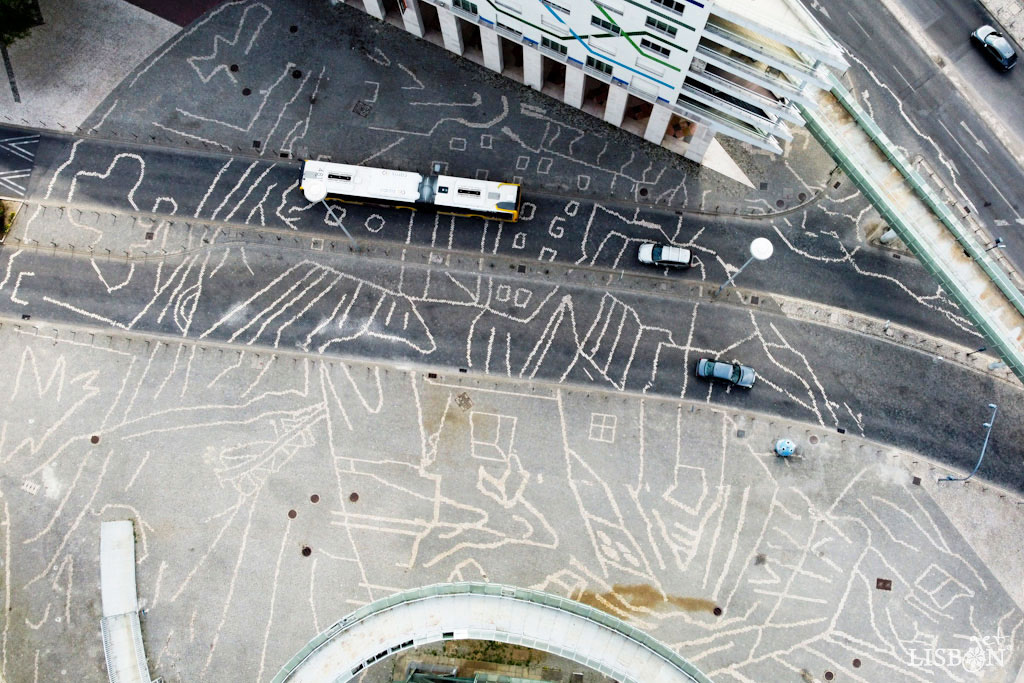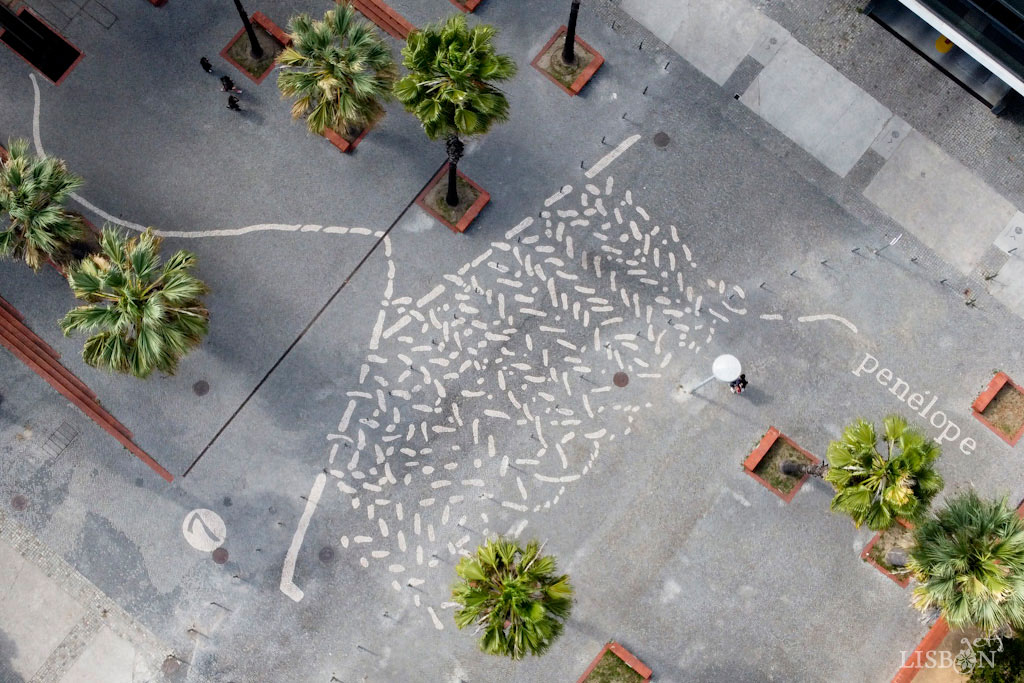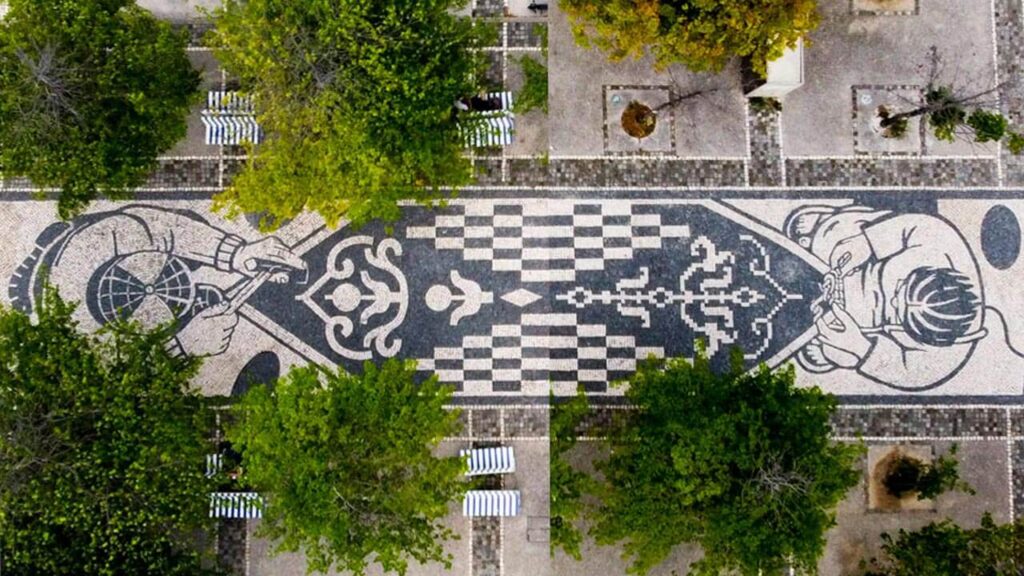Original article published on 24 June 2022
In this article, we’ll get to know the Portuguese pavement in Parque das Nações through bird’s-eye views that allow us to have new and surprising perspectives. Indeed, many of these artworks tell stories and they only have real impact and meaning if observed in their entirety.
The current area of Parque das Nações is the result of the urban conversion and environmental rehabilitation project of a run-down area of eastern Lisbon, which resulted from the Lisbon World Exposition 98 under the theme “The Oceans: A Heritage for the Future”.
All the infrastructure, buildings, urban furniture…, even the public art, were planned for its permanence after the exhibition.
The Portuguese pavement is one of them.
6 Pieces of Art in the Portuguese Pavement in Parque das Nações
For Expo 98, six Portuguese artists were invited for the Portuguese pavement projects: Pedro Calapez, Fernanda Fragateiro, Pedro Proença, Xana (Alexandre Barata), Fernando Conduto and Rigo (Ricardo Gouveia).
In a different approach from the traditional one, which generally is the use of repetition or alternation of modules that form patterns, these artists proposed, in general, free elements that tell stories, symbolism, relationships with surrounding elements… These artworks, on the one hand, reveal originality, but on the other hand, are difficult to interpret when observed from the ground.
Therefore, we used technology to bring you another perspective of the Portuguese pavement in Parque das Nações, starting our journey from the extreme south.
Untitled – Pedro Calapez

The Portuguese pavement designed by Pedro Calapez is located next to the Galp Tower, the only element that still remains from the old refinery that once stood here, today a symbol of memory of the industrial activity in this area.
The author’s intention was to offer different readings of his work to the visitor: “a non-repetitive, non-standardized drawing that is totally related to my artistic practice, proposes a “view” through different “perspectives”. For those passing by, they are lines, pieces of branches, doors, stairs, evocations of interior spaces on an exterior, discovering the drawing little by little, in which the feeling of continuity is only possible in articulation with memory. It will only be when you go up to the tower that you’ll get a global view, the unification of the drawing which was previously seen in parts. However, you’ll be surprised again as you’ll see that the drawing is made up of heterogeneous parts that sometimes connect to each other but do not reveal a scene with a global meaning…”
Unfortunately, the plan to access the tower through a restaurant or, later, a viewpoint, did not happen, which makes being surprised by the “global view” and the full reading of this art piece impossible.
Pedro Calapez was born in Lisbon in 1953, studied at the Fine Arts Faculty, worked as a professional photographer, but it’s in painting that he stands out as one of the most recognised national names.


Penelope – Fernanda Fragateiro

Let’s continue to Jardim da Água (Garden of Water). This space, which aims to illustrate different environments along a watercourse from its spring, is subdivided into: Jardim das Palmeiras (Garden of Palm), Pomar do Mediterrâneo (Orchard of the Mediterranean), Lago de Ulisses (Lake Ulysses), Cascata (Waterfall) and Jardim Hidráulico (Hydraulic Garden).
While strolling through this vast area, we can find a set of artworks by Fernanda Fragateiro: Cortina (curtain), Bancos (benches), Espelhos (mirrors), Sombras (shadows) and Penelope.
The latter, a knitted drawing made in Portuguese pavement of white limestone on black limestone, evokes the wife of Ulysses, king of Ithaca and protagonist in the epic poem Odyssey, attributed to Homer.
Penelope personifies cunning and marital fidelity. After years without news of her husband, who had been fighting in the Trojan War, and forced to marry one of the pretenders to the throne, she set the condition that this would happen only when the shroud she was weaving for her father-in-law was finished. Deciding to wait for her husband, she adopted the stratagem of undoing every night what she had done during the day, which allowed her to postpone the engagement a few more years until Ulysses returned.
Fernanda Fragateiro, born in 1962, is a multifaceted artist whose work includes sculpture, installation art, illustration, art pieces for architecture and landscaping projects, among others.
Monstros Marinhos (Sea Monsters) – Pedro Proença
Monstros Marinhos, Portuguese pavement by Pedro Proença
The entire front of the Lisbon Aquarium up to José Mariano Gago Square is populated by sea monsters by Pedro Proença. This visual artist, born in Angola in 1962, brings us drawings that take us to the imaginary world, through the metamorphosis and/or osmosis of inanimate, human, animal or plant forms.
In this Portuguese pavement we can see beings such as starfish, octopuses, snakes, fish, elephant seals, molluscs… which mostly show human expressions and characteristics such as smiles, eyes, nose, eyebrows and even a hand with a fish tail.
These figures remind us of the sea creatures from medieval and renaissance sea charts. Serpents, mermaids, monsters… symbolised dangers for navigation in unexplored and mysterious regions.
The marine monsters on the Portuguese pavement in Parque das Nações call for our imagination, but they are also intended to alert us to the dangers and threats that marine ecosystems are currently subject to due to human activity.
Calçada do Mar Português – Xana (Alexandre Barata)

In the same area, in Cais Português, next to Pavilhão do Conhecimento (Pavilion of Knowledge) and across about 600 metres, we can see compositions by Xana. These are the only ones that don’t require an aerial view for their understanding.
These are abstract geometric shapes made up of white and black limestone inlaid in a dark granitic stone pavement, unfortunately in a very irregular condition, which makes it difficult to walk along safely.
According to available information, the designs of this Portuguese pavement were inspired by the plans and elevations of Pavilhão do Conhecimento. Indeed, among many different elements, we identified some that can be related with the glass bricks and wooden beams present on the façade of this building.
The motifs of this Portuguese pavement also remind us of a computerised image, in which each stone corresponds to a pixel.
Alexandre Barata is a visual artist, born in 1959, who produces very diverse works, including: sculpture, installation art, painting, scenography, urban art… He is represented in national and foreign art collections and museums.
Mar Largo – Fernando Conduto

Rossio dos Olivais is the next stopping point, in the middle of Parque das Nações, where the flags of organisations and countries participating in Expo98 can be found, as well as the giant Iberian lynx, created in 2019, by Bordalo II.
Here you can see the Portuguese pavement called Mar Largo (Wide Sea), which immediately takes us back to the emblematic pattern of Rossio square, which was the first to be executed in a public space in Lisbon and which was featured in our article The Origin of the Portuguese Pavement and its First Exemplars.
Fernando Conduto (1937), a multifaceted plastic artist with works in various areas such as sculpture, painting, design or medals design… recreates this theme through irregular wavy lines that seem to be the movement of a watercourse that reaches a wider area before flowing into the Tagus river.The aerial pictures and the reference in the article Pisando Arte e Matemática em Lisboa(1) allowed us to bring an additional observation that will hardly be noticeable when walking on this pavement. The apparently free and non-standard strokes hide the use of four modules (M1 to M4), repeated alternately, forming a frieze, as the diagram illustrates:

This frieze ends before reaching the river, opening onto a quadrangular space, where only modules 1 and 2 are applied, creating a pattern. The two modules were designed to be joined both horizontally and vertically.

(1) Pisando Arte e Matemática em Lisboa, Alda Carvalho, Carlos Pereira dos Santos, Jorge Nuno Silva, Ricardo Cunha Teixeira, Revista Convocarte Nº2, Setembro 2016, Centro de Investigação e de Estudos em Belas-Artes da Faculdade de Belas-Artes da Universidade de Lisboa.
| Never miss another article | Subscribe here |
Caminho de Água – Rigo (Ricardo Gouveia)
We suggest that you continue north to Rotunda dos Vice-Reis and follow the path back along Alameda dos Oceanos.Along 1.5km, between the colourful water volcanoes, there are numerous motifs in Portuguese pavement called Caminho de Água (Water Path): graphic and written elements, figures… all by Rigo.
Caminho de Água, Portuguese pavement by Rigo
But the composition that surprised us the most is that of two characters seen from above working simultaneously on a piece composed of plant motifs and a chess pattern.
On the left, a paver seated on his bent left leg hammers a stone cube. On the other, a female figure, wearing glasses and flip-flops, is seated crocheting. Each one builds, through their craft, a common piece.
In the centre of the drawing, you can read the word “SODÁDE” in Cape Verdean Creole, which reminds us of the song popularised by the singer Cesária Évora and which suggests the connection between Portugal and other Portuguese-speaking countries.

Ricardo Gouveia (1966) was born and raised in Madeira Island, having emigrated to the USA in 1985, more precisely to San Francisco, where he studied and began his artistic career. His works range from painting and comics to public art and often reflect the theme of multiculturalism.
Having reached the end of this itinerary of Portuguese pavement in Parque das Nações, we hope in your next visit to this part of the city, your attention will also be drawn to the art of paving, this time with a new perspective.
The project getLISBON has been very rewarding and we want to continue revealing the singularities of fascinating Lisbon.
Help us keep this project alive!
By using these links to make your reservations you’ll be supporting us. With no extra costs!
• Looking for a different experience? We can create a customised itinerary based on your interests. Contact us!
• Or if you prefer tours and other activities in various destinations, take a look at GetYourGuide.
• Save time and money with a flexible Lisbon Card!




